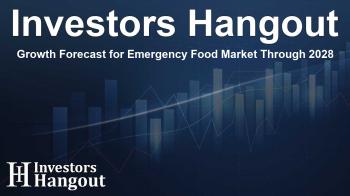Growth Forecast for Emergency Food Market Through 2028

Emergency Food Market Expansion Trends
The emergency food market is witnessing a remarkable growth trajectory, expected to increase by USD 3.20 billion between 2024 and 2028. This growth is largely driven by the expanding organized retail sector and a shift towards organic freeze-dried foods, with a projected Compound Annual Growth Rate (CAGR) of 7.35%. The demand for quick and accessible food options amidst natural disasters and unforeseen events has never been more critical.
Key Market Dynamics Influencing Growth
Emerging trends in the emergency food sector are largely propelled by the rise of food preservation techniques like freeze-drying, which significantly extends shelf life. Freeze-dried offerings such as peanut butter, dried fruits, and canned juice cater to the growing need for non-perishable items in disaster relief and outdoor activities. The landscape is influenced by an increase in climate-related crises, which heightens the importance of ready-to-eat meals for individuals preparing for emergencies.
Rising Popularity of Organic Freeze-Dried Foods
As health consciousness grows among consumers, the demand for organic freeze-dried products also rises. This trend is particularly evident in markets with increasing vegan populations, prompting a shift towards gluten-free and allergen-free options. Vendors are required to meet stringent organic standards during their production processes. This focus on nutrition, paired with the convenience of freeze-dried foods, presents a lucrative opportunity for businesses in this sector.
Market Challenges Faced by the Industry
Despite growth opportunities, the emergency food market confronts challenges such as rigorous regulatory frameworks. Adhering to government standards for food safety is paramount, involving processes like licensing, inspections, and compliance with food safety protocols. Investments in safety management systems like ISO 22000 and BRC Food Standards are essential to ensure consumer trust and regulatory compliance.
Changing Consumer Preferences and Dietary Needs
The increasing diversity in consumer dietary preferences is central to the market's evolution. More individuals are seeking gluten-free, vegan, and non-allergenic products, prompting retailers and manufacturers to adapt their offerings. This shift signifies a broader social change towards healthier lifestyles and preparedness strategies during emergencies.
Segment Analysis of the Emergency Food Market
This report delves into significant segments within the emergency food market. Key categories include ready-to-eat meals, non-perishable milk, dried fruits, and infant food products. The distribution landscape encompasses both offline and online sales channels, ensuring accessibility of essential food supplies to consumers.
Focus on Ready-To-Eat Meals
The segment for ready-to-eat meals has emerged as a vital driver of the emergency food market. These products provide a quick, nutritious solution during emergencies, making them indispensable for disaster relief efforts and personal preparedness. The rise in natural disasters highlights the increased necessity for convenient food sources that do not require cooking or refrigeration.
Technological Innovations Transforming the Market
Technological advancements are driving significant changes in food preservation and packaging methods. Artificial Intelligence is increasingly being utilized to enhance market analysis and identify emerging trends, allowing businesses to tailor their strategies effectively. The incorporation of innovative technologies positions companies favorably within a competitive landscape.
The Defense Sector's Role in Emergency Food Procurement
The defense sector is a major consumer of emergency food products, necessitating consistent supply chains and large-scale procurement strategies. Contracts for emergency food items ensure that military logistics remain intact, reinforcing the market's importance in national security efforts.
Conclusion
The emergency food market stands on the brink of substantial growth, driven by both consumer needs and industry advancements. As businesses adjust to regulatory requirements and consumer preferences, the integration of sustainable practices will become increasingly important. The focus remains on providing high-quality, nutritious foods that can withstand the test of time, particularly during emergencies.
Frequently Asked Questions
What factors are driving the growth of the emergency food market?
Growth is driven by the rise of the organized retail sector, increased demand for ready-to-eat meals, and the popularity of organic freeze-dried foods.
How significant is the demand for organic freeze-dried foods?
The demand is substantial due to increasing health consciousness and preference for natural products among consumers, especially in markets with growing vegan populations.
What challenges does the emergency food market face?
Regulatory compliance, food safety standards, and managing the diverse dietary requirements of consumers are some of the prominent challenges.
What segments are prominent within the emergency food market?
Key segments include ready-to-eat meals, dried fruits, non-perishable milk, and infant food, with both online and offline sales channels being utilized.
How are technological advancements impacting the market?
Technology, particularly AI, is transforming market analysis, providing businesses with insights that help them adapt to changing consumer needs and market dynamics.
About The Author
Contact Lucas Young privately here. Or send an email with ATTN: Lucas Young as the subject to contact@investorshangout.com.
About Investors Hangout
Investors Hangout is a leading online stock forum for financial discussion and learning, offering a wide range of free tools and resources. It draws in traders of all levels, who exchange market knowledge, investigate trading tactics, and keep an eye on industry developments in real time. Featuring financial articles, stock message boards, quotes, charts, company profiles, and live news updates. Through cooperative learning and a wealth of informational resources, it helps users from novices creating their first portfolios to experts honing their techniques. Join Investors Hangout today: https://investorshangout.com/
The content of this article is based on factual, publicly available information and does not represent legal, financial, or investment advice. Investors Hangout does not offer financial advice, and the author is not a licensed financial advisor. Consult a qualified advisor before making any financial or investment decisions based on this article. This article should not be considered advice to purchase, sell, or hold any securities or other investments. If any of the material provided here is inaccurate, please contact us for corrections.

